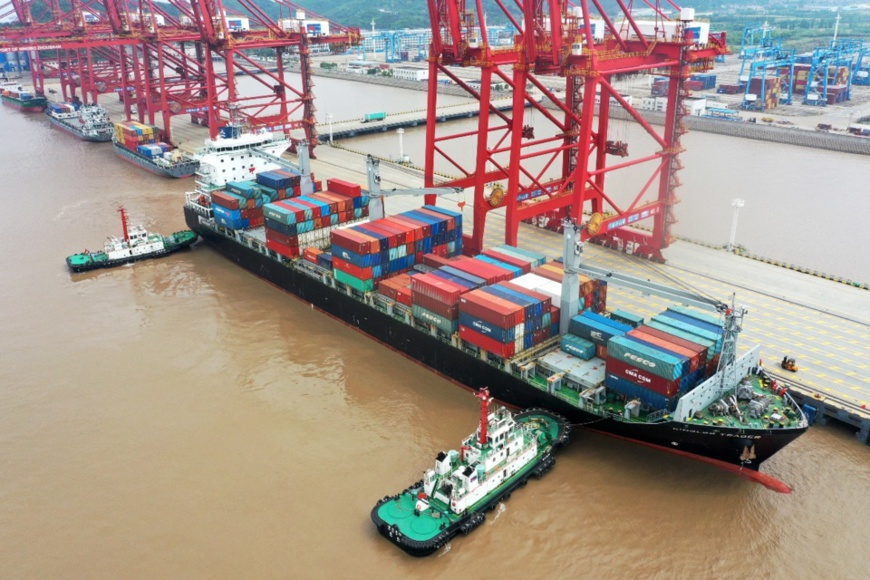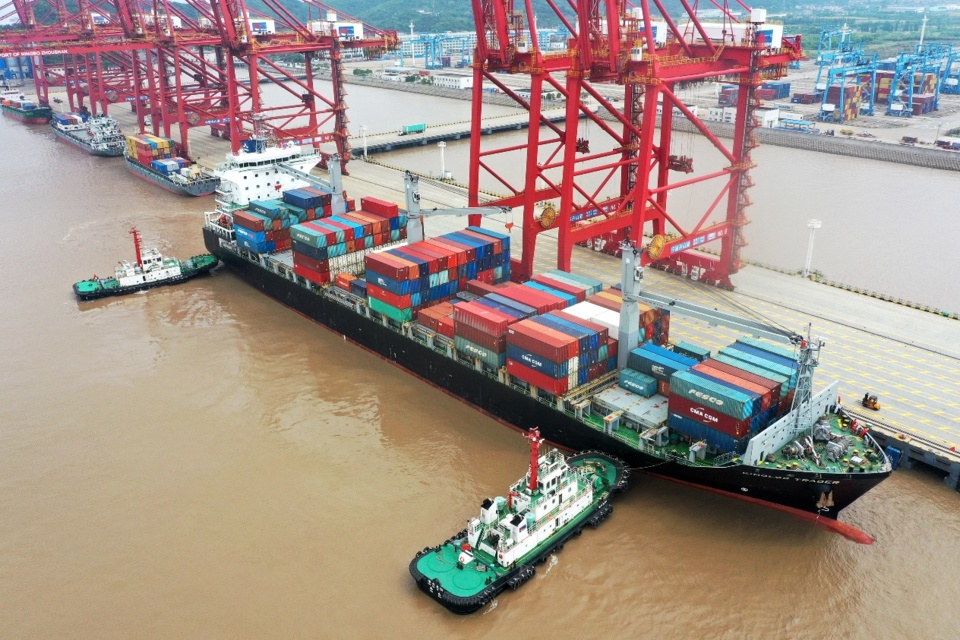By Cheng Shijie, People's Daily

A vessel serving Belt and Road countries is berthed at the Ningbo Zhoushan Port, east China's Zhejiang province, May 7. (By Yaofeng, People's Daily Online)
Although the novel coronavirus pneumonia outbreak has struck at global economic and trade cooperation, trade and exchanges under China's Belt and Road Initiative (BRI) still secured progress.
During the first quarter of 2020, China's trade with countries along the Belt and Road increased by 3.2 percent, 9.6 percentage points higher than the overall growth rate of China's foreign trade volume, said Ning Jizhe, deputy head of the National Development and Reform Commission, during a May 24 press conference held by the State Council Information Office.
On that same day, State Councilor and Foreign Minister Wang Yi underscored the importance of the Belt and Road cooperation in combating the pandemic at a press conference on China's foreign policy and diplomatic relations.
Evidence suggests that the pandemic has strengthened, not restrained, the cooperation under the BRI framework.
Chinese factories have operated at full capacity to make high-quality medical supplies and equipment that are badly needed around the world, exporting 56.8 billion surgical masks and 250 million protective gowns, among other provisions, Wang noted.
To date, China has shipped medical supplies to nearly 150 countries and four international organizations to meet their immediate needs and sent 26 expert teams to 24 countries to provide timely information and in-person guidance, according to Wang.
Besides, China's initiative of building a Silk Road of Health is being responded by more and more countries.
Infrastructure and public well-being projects under the BRI have played an important role for partner countries during the COVID-19 pandemic. The energy projects along the China-Pakistan Economic Corridor (CPEC), for one, have remained operation during the outbreak and generated one third of Pakistan's electricity.
When flights were largely grounded by the pandemic, the trips made by and the cargo volume of the China-Europe freight trains grew 24 percent and 27 percent, respectively in the January-April period from a year earlier.
The rail cargo service has transported nearly 8,000 tons of anti-pandemic materials, becoming a "way of life" on the Eurasian continent.
Ning pointed out that the regular epidemic prevention and control has highlighted the role of new economic and trade models, including cross-border e-commerce, online exhibition, online investment attraction and cloud videos.
He also pointed out that China will promote cooperation with Belt and Road countries in the fields such as big data, Internet plus and smart cities, to jointly build a digital Silk Road.
Even since the BRI was proposed in 2013, an increasing number of countries have participated in the construction of the initiative. Highways and railways, bridges and tunnels, factories and industrial parks, as well as hospitals and schools are being built massively in participating countries. As a Chinese saying goes, "Nothing, not even mountains and oceans, can separate people with shared goals and vision."
The Belt and Road construction is still full of opportunities, with countries continuously expanding new areas of cooperation. It is believed that countries will be more motivated to develop economy and improve the living standards of the people after the pandemic, with increasing demands for the cooperation in public health.
During the first quarter of 2020, China's trade with countries along the Belt and Road increased by 3.2 percent, 9.6 percentage points higher than the overall growth rate of China's foreign trade volume, said Ning Jizhe, deputy head of the National Development and Reform Commission, during a May 24 press conference held by the State Council Information Office.
On that same day, State Councilor and Foreign Minister Wang Yi underscored the importance of the Belt and Road cooperation in combating the pandemic at a press conference on China's foreign policy and diplomatic relations.
Evidence suggests that the pandemic has strengthened, not restrained, the cooperation under the BRI framework.
Chinese factories have operated at full capacity to make high-quality medical supplies and equipment that are badly needed around the world, exporting 56.8 billion surgical masks and 250 million protective gowns, among other provisions, Wang noted.
To date, China has shipped medical supplies to nearly 150 countries and four international organizations to meet their immediate needs and sent 26 expert teams to 24 countries to provide timely information and in-person guidance, according to Wang.
Besides, China's initiative of building a Silk Road of Health is being responded by more and more countries.
Infrastructure and public well-being projects under the BRI have played an important role for partner countries during the COVID-19 pandemic. The energy projects along the China-Pakistan Economic Corridor (CPEC), for one, have remained operation during the outbreak and generated one third of Pakistan's electricity.
When flights were largely grounded by the pandemic, the trips made by and the cargo volume of the China-Europe freight trains grew 24 percent and 27 percent, respectively in the January-April period from a year earlier.
The rail cargo service has transported nearly 8,000 tons of anti-pandemic materials, becoming a "way of life" on the Eurasian continent.
Ning pointed out that the regular epidemic prevention and control has highlighted the role of new economic and trade models, including cross-border e-commerce, online exhibition, online investment attraction and cloud videos.
He also pointed out that China will promote cooperation with Belt and Road countries in the fields such as big data, Internet plus and smart cities, to jointly build a digital Silk Road.
Even since the BRI was proposed in 2013, an increasing number of countries have participated in the construction of the initiative. Highways and railways, bridges and tunnels, factories and industrial parks, as well as hospitals and schools are being built massively in participating countries. As a Chinese saying goes, "Nothing, not even mountains and oceans, can separate people with shared goals and vision."
The Belt and Road construction is still full of opportunities, with countries continuously expanding new areas of cooperation. It is believed that countries will be more motivated to develop economy and improve the living standards of the people after the pandemic, with increasing demands for the cooperation in public health.
 Menu
Menu
 Anti-pandemic cooperation further expands Belt and Road cooperation
Anti-pandemic cooperation further expands Belt and Road cooperation
















